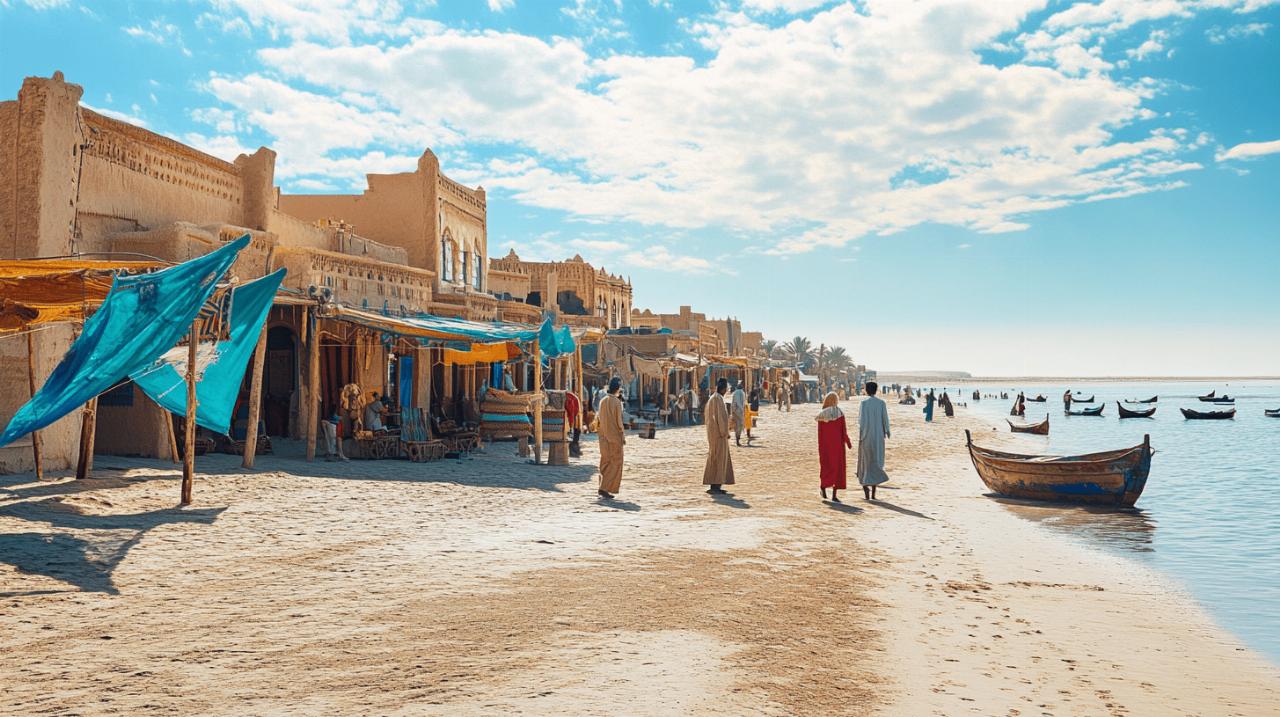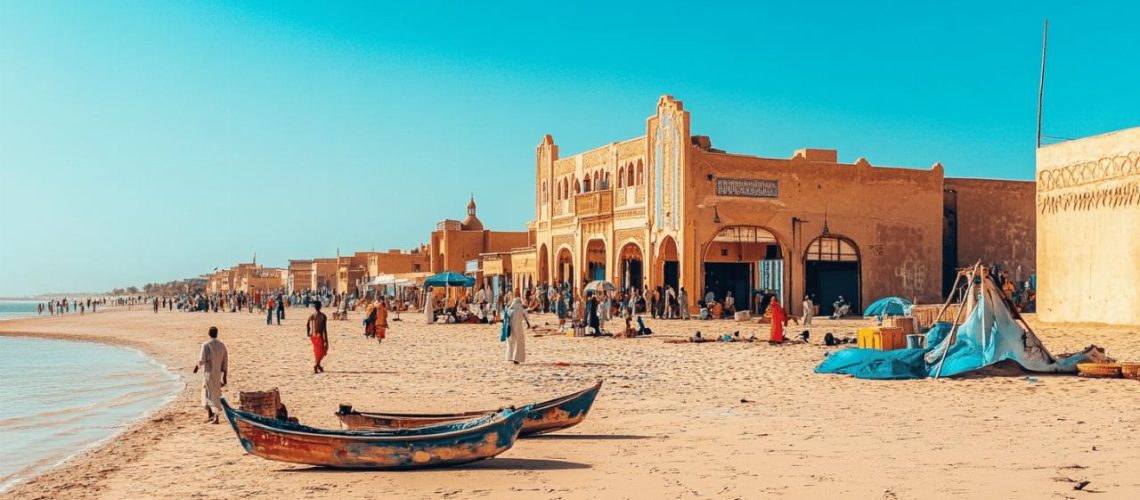Dakhla Beach, where the mighty Sahara Desert embraces the Atlantic Ocean, stands as one of Morocco's most captivating cultural treasures. This coastal haven, situated on a 40-kilometre peninsula about 1,700 kilometres from Casablanca, offers visitors not just stunning landscapes but a rich tapestry of traditions waiting to be discovered. With consistent weather year-round and remarkable natural features, Dakhla has become known as a destination where adventure meets cultural immersion. Many travellers share their experiences on platforms like https://www.travelling-dolls.de/, documenting their wild adventures at this unique Moroccan jewel.
The enchanting heritage of dakhla beach
The cultural narrative of Dakhla begins with its fascinating history. Originally established by Spanish settlers in 1844 as Villa Cisneros, the region carries a distinctive blend of Moroccan, Spanish, and African influences. After Spain withdrew in 1975, the area came under joint administration by Morocco and Mauritania before eventually becoming part of Morocco. This complex historical journey has created a unique cultural identity that sets Dakhla apart from other Moroccan destinations.
Meeting the Saharawi: Guardians of Desert Traditions
The Saharawi people, traditional inhabitants of this region, serve as the living custodians of Dakhla's cultural heritage. Their warmth and hospitality immediately welcome visitors into their world—a world shaped by centuries of adaptation to desert life. Through genuine interactions with Saharawi families, travellers gain insights into traditional nomadic practices that have sustained communities in this challenging landscape for generations. The Saharawi way of life represents a harmonious relationship with nature, balancing resource conservation with survival needs in the harsh desert environment.
Historical tapestry: tracing dakhla's cultural evolution
The historical landmarks scattered throughout Dakhla tell stories of its varied past. The Spanish Lighthouse stands as a sentinel to colonial times, while archaeological sites reveal layers of human settlement stretching back centuries. Walking through Dakhla today, one witnesses the remarkable transformation that has earned it the nickname 'city of the future' among locals. With Morocco's largest airport connecting it directly to European capitals like Paris and London, and significant infrastructure developments including one of Africa's largest water treatment centres, Dakhla balances preservation of heritage with forward-looking development.
Artistic expressions of dakhla
Dakhla's cultural identity finds powerful expression through its arts and crafts, which serve as tangible connections to ancestral traditions while adapting to contemporary influences. These artistic practices not only preserve cultural knowledge but also provide economic opportunities for local communities.
Master craftspeople: the living legacy of traditional arts
In workshops throughout Dakhla, master artisans create exquisite handcrafted items that reflect generations of expertise. Silver jewellery featuring intricate desert motifs and geometric patterns tells stories of tribal affiliations and social status. Vibrant textiles woven with techniques passed down through families transform raw materials into functional art. Each piece created represents not just an item of beauty but a vessel of cultural memory. Visitors can observe these craftspeople at work in local markets, where the creative process becomes a form of cultural dialogue between maker and observer.
Rhythms of the Sahara: Music and Dance Traditions
The soul of Dakhla resonates through its distinctive musical traditions. Evenings come alive with the hypnotic sounds of traditional instruments accompanying songs that narrate tales of desert life, love, and historical events. During the annual Dakhla Festival held each July, these musical traditions take centre stage, with performances that showcase the region's rich cultural heritage. Dance forms unique to the area involve intricate footwork and graceful hand movements that mime everyday activities from fishing to camel herding. These performances are not mere entertainment but vital expressions of community identity and historical memory.
Culinary adventures in dakhla
The gastronomic landscape of Dakhla offers a sensory journey through its cultural history, with flavours reflecting both its coastal position and desert heritage. Food here serves as a delicious gateway to understanding the region's cultural fusion.
Flavours of the Atlantic: Seafood Delicacies
As a coastal peninsula, Dakhla boasts some of Morocco's finest seafood cuisine. The waters surrounding the region yield an abundance of fresh fish, crustaceans, and the famous Dakhla oysters—premium delicacies primarily exported to European markets. In the Fishermen's Quarter, visitors can watch as the day's catch arrives and transforms into mouthwatering dishes in nearby restaurants. Seafood tagines infused with local spices offer a perfect marriage of Moroccan cooking techniques with Atlantic ingredients. The region's oyster farms, visible from shore, represent both a culinary treasure and an important economic resource for the community.
Desert gastronomy: nomadic culinary influences
Away from the coast, Dakhla's cuisine incorporates elements of traditional desert food preparation. Slow-cooked meats seasoned with preserved lemons, olives, and aromatic spices reflect the nomadic heritage of the region. Mint tea ceremonies here follow precise rituals that honour guests and create moments of connection. Many dishes feature locally sourced ingredients like argan oil and desert herbs, which also appear in traditional spa treatments and remedies. The culinary traditions showcase remarkable ingenuity in creating flavourful, nutritious meals in an environment where resources must be carefully managed.
Markets and community life
The markets of Dakhla serve as vibrant community hubs where commerce, socializing, and cultural exchange converge. These bustling spaces offer visitors authentic glimpses into daily life and opportunities for meaningful interactions with locals.
Navigating dakhla's souks: a treasure hunt
The Souss-Massa Market stands as the commercial heart of Dakhla, where narrow alleyways lead shoppers through a sensory labyrinth of colours, aromas, and sounds. Here, artisans display their crafts alongside vendors selling fresh produce, spices, and household goods. Unlike more tourist-oriented markets in other parts of Morocco, Dakhla's souks primarily serve the local community, creating a more authentic shopping experience. Bargaining is expected but should be approached as a friendly exchange rather than aggressive haggling. The market rhythm follows traditional patterns, with different sections coming alive at various times of day according to ancient commercial customs.
Social customs: etiquette and interactions
Understanding local social customs enhances cultural connections in Dakhla. Greetings hold special importance, with handshakes typically extended between same-gender individuals while maintaining respectful distance between men and women. When invited into homes, removing shoes and bringing a small gift demonstrates appreciation for hospitality. Communal meals often involve sitting on floor cushions around a central dish, with food taken from the section directly in front of each diner using the right hand. These social protocols reflect values of respect, community, and hospitality deeply embedded in local culture.
Connecting with local culture
Meaningful cultural immersion requires thoughtful engagement with language, traditions, and community activities. By approaching these connections with respect and genuine curiosity, visitors create memorable exchanges that enhance understanding between cultures.
Language bridges: basic arabic for travellers
While many people in Dakhla's tourism sector speak some English or French, learning basic Arabic phrases demonstrates respect and facilitates deeper connections. Simple greetings like 'Assalamu alaikum' and expressions of gratitude such as 'Shukran' open doors to warmer interactions. The local dialect incorporates elements of Hassaniya Arabic with influences from Berber languages, creating a linguistic landscape as diverse as the cultural heritage. Even imperfect attempts at speaking the local language are typically met with appreciation and encouragement from residents eager to share their culture.
Cultural immersion: participating in local festivities
Seasonal celebrations offer windows into the heart of Dakhla's cultural life. Beyond the July Dakhla Festival, religious holidays and seasonal events mark the community calendar with opportunities for visitor participation. Some eco-tourism initiatives invite travellers to join community projects focused on preserving the fragile desert ecosystem or supporting sustainable development. Through these shared activities, visitors move beyond passive observation to active engagement with the living culture. From camel trekking across the desert to stargazing under pristine night skies, these experiences connect travellers to both the natural environment and cultural traditions that have evolved in harmony with it.

